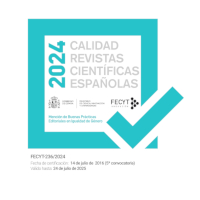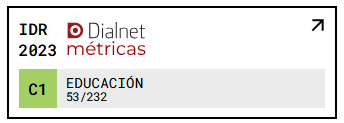The "flipped classroom" as an active methodology to promote centrality in the students as protagonist of their own learning
DOI:
https://doi.org/10.18172/con.4727Keywords:
Higher education, flipped classroom, teaching-learning, perception studentsAbstract
Teaching-learning processes in university degrees, and especially graduate degrees, are evolving towards a digital contents improvement and the use of learning platforms and academic management. In this sense, the "flipped classroom" lies in turning the traditional lessons in order to make students the active protagonists of their own learning. In the subject called Contemporary Trends in Education studied on the second year of the Primary Education Teacher Degree, this methodology has been implemented. The objective of this work was to experience this subject and assess the degree of student satisfaction in this methodology. In order to do this, the questionnaire about student perceptions regarding the flipped classroom was used (Gilboy et al., 2015). The results demonstrate that students prefer to participate in class through active and group work rather than in a traditional class. The application of this educational model promotes a better exploitation of time in the classroom, the use of Information and Communication Technologies and collaboration between students, motivation and focus on students as the protagonists of their own learning.
Downloads
References
Aguilera, C., Manzano, A., Martínez, I., Lozano, M. C. y Casiano, C. (2017). El modelo flipped classroom. International Journal of Developmental and Educational Psychology, 4(1), 261-266. https://doi.org/10.17060/ijodaep.2017.n1.v4.1055
Ash, K. (2012). Educators evaluate "flipped classrooms”. Education Week, 32(2), s6-s8.
Awidi, I. T. y Paynter, M. (2018). The impact of a flipped classroom approach on student learning experience. Computers & Education, 128, 269-283. https://doi.org/10.1016/j.compedu.2018.09.013
Aznar, I., Cáceres, M. P. y Romero, J. M. (2018). Indicadores de calidad para evaluar buenas prácticas docentes de mobile learning en educación superior. Education in the Knowledge Society (EKS), 19(3), 53-68. https://doi.org/10.14201/eks20181935368
Bergmann, J. y Sams, A. (2012). Flip Your Classroom: Reach Every Student in Every Class Every Day (pp. 120-190). International Society for Technology in Education.
Bergmann, J. y Sams, A. (2014). Dale la vuelta a tu clase. Lleva tu clase a cada estudiante, en cualquier momento y cualquier lugar. SM (2ª ed).
Castilla, G., Alriols, J., Romana, M., y Escribano, J. J. (2015). Resultados del estudio experimental de flipped learning en el ámbito de la enseñanza de matemáticas en ingeniería. En M. A. Ruiz Rosillo (Coord.), Actas de las XII Jornadas Internacionales de Innovación Universitaria (pp. 774-782). Universidad Europea de Madrid.
Cebrián-Martínez, A., Palomares-Ruiz, A. y García-Perales, R. (2019). El aprendizaje autorregulado y su efecto en el rendimiento académico. Descripción de una experiencia con los alumnos del Grado de Maestro de la Facultad de Educación de Albacete (estudio intersujetos). En R. Roig-Vila (Ed.), Investigación e Innovación en la Enseñanza Superior. Nuevos contextos, nuevas ideas (pp. 66-79). Ediciones Octaedro.
Contreras, J. A., Arias, J., Melo, M. G. y Martín, R. (2017). Uso del modelo de aprendizaje inverso para mejorar materiales educativos universitarios. Revista lbérica de Sistemas y Tecnologías de Información, 23, 17-32. https://doi.org/10.17013/risti.23.17-32
Faundez, A. R. O., Bastias, J. M. A. y Polanco, M. P. R. (2016). Evaluación de metodología flipped classroom: Primera experiencia. Innoeduca. International Journal of Technology and Educational Innovation, 2(2), 90-99.
García-Gil, D. y Cremades-Andreu, R. (2019). Flipped classroom en educación superior: Un estudio a través de relatos de alumnos. Revista Mexicana de Investigación Educativa, 24(80), 101-123.
George, D., y Mallery, P. (2003). SPSS for Windows step by step: A simple guide and reference. 11.0 update. Allyn & Bacon.
Gilboy, M. B., Heinerichs, S., y Pazzaglia, G. (2015). Enhancing student engagement using the flipped classroom. Journal of Nutrition Education and Behavior, 47(1), 109-114. https://doi.org/10.1016/j.jneb.2014.08.008
Gonçalves, Z. T. y Quaresma, D. (2018). Metodologia activa: Sala de aula invertida e suas práticas na educação básica. REICE. Revista Iberoamericana sobre Calidad, Eficacia y Cambio en Educación, 16(4), 63-78. https://doi.org/10.15366/reice2018.16.4.004
Hernández, C. y Tecpan, S. (2017). Aprendizaje por indagación para la construcción de arquetipos en física; el caso de un curso para formación de profesores en Chile. Latin-American Journal of Physics Education,11(2).
Hinojo, F. J., Mingorance, A. C., Trujillo, J. M., Aznar, I. y Cáceres, M. P. (2018). Incidence of the flipped classroom in the physical education students' academic performance in university contexts. Sustainability, 10(5), 1-13. https://doi.org/10.3390/su10051334
Jordan-Lluch, C., Pérez Peñalver, M. y Sanabria-Codesal, E. (2014). Flipped classroom: Reflexiones y opiniones de los implicados. En Jornadas de Innovación Educativa y docencia en Red de la Universitat Politècnica de València (pp. 310-323). Universitat Politècnica de València. https://doi.org/10.1109/isie.2007.4375002
Lara, S., y Rivas, S. (2009). Aprendizaje autorregulado y fomento de competencias en dos asignaturas de máster a través del empleo de plantillas de evaluación, método del caso, role-playing y video digital. Revista Educación XXI, 12, 67-96.
Matzumura, J. P., Gutiérrez, H., Zamudio, L. A. y Zavala, J. C. (2018). Aprendizaje invertido para la mejora y logro de metas de aprendizaje en el curso de metodología de la investigación en estudiantes de universidad. Revista Electrónica Educare, 22(3), 1-21. https://doi.org/10.15359/ree.22-3.9
Miragall, M. y García-Soriano, G. (2016). Transformando una clase del grado en psicología en una flipped classroom. @TIC. Revista d’Innovació Educativa, 17, 21-29. https://doi.org/10.7203/attic.17.9097
O’Flaherty, J. y Phillips, C. (2015). The use of flipped classrooms in higher education: A scoping review. The Internet and Higher Education, 25, 85-95.
Palomares Ruiz, A. y Cebrián Martínez, A. (2016). Una experiencia de Flipped Classroom o Aula Invertida en la Facultad de Educación de Albacete. En R. Roig-Vila (Coord.), Tecnología, innovación e investigación en los procesos de enseñanza-aprendizaje, (pp. 2860-2871). Ediciones Octaedro.
Pérez Juste, R. (2013). Evaluación Institucional al Servicio de la Calidad de la Organización Educativa. I Jornadas Internacionales sobre liderazgo y calidad de la educación. Mayo. (pp. 17-24).
Reyes, A. E. (2015). Educación y formación en la Unión Europea: Análisis del proceso de Bolonia, el espacio europeo de educación superior, la estrategia Europa 2020 y el programa Erasmus+. Derecho y Cambio Social, 12(42), 1-23.
Rosenberg, T. (2013). Turning Education Upside Down. http://opinionator.blogs.nytimes.com/2013/10/09/turning-education-upside-down/
Santiago, R. (2013). The Flipped classroom. https://www.theflippedclassroom.es/
Santiago, R. y Bergmann, J. (2018). Aprender al revés. Flipped Learning 3.0 y metodologías activas en el aula. Paidós Educación.
Tiahrt, T. y Jason, C. P. (2016). What Do I Do with this Flipping Classroom: Ideas for Effectively Using Class Time in a Flipped Course. Business Education Innovation Journal, 8(2), 85-91.
Tourón, J. (2013). The Flipped Classroom: ¿no has ‘flipado’ aún? http://www.javiertouron.es/2013/06/the-flipped-classroom-no-has-flipado.html
Tourón, J. y Santiago, R. (2015). El modelo flipped learning y el desarrollo del talento en la escuela. Revista de Educación, 368, 196-231. https://doi.org/10.4438/1988-592X-RE-2015-368-288.
Tourón, J., Santiago, R. y Diez, A. (2014). The Flipped Classroom: Cómo convertir la escuela en un espacio de aprendizaje. Grupo Océano.
Tucker, B. (2012). The flipped classroom. Education Next, 12(1), 82-83. http://educationnext.org/the-flipped-classroom
Vidal, M., Rivera, N., Nolla, N., Morales, I. R. y Vialart, M. N. (2016). Aula invertida, nueva estrategia didáctica. Educación Médica Superior, 30(3), 1-12.
Downloads
Published
How to Cite
Issue
Section
License
The authors retain copyright of articles and authorize Contextos Educativos. Revista de Educación the first publication. They are free to share and redistribute the article without obtaining permission from the publisher as long as they give appropriate credit to the editor and the journal.
Self-archiving is allowed too. In fact, it is recommendable to deposit a PDF version of the paper in academic and/or institutional repositories.












